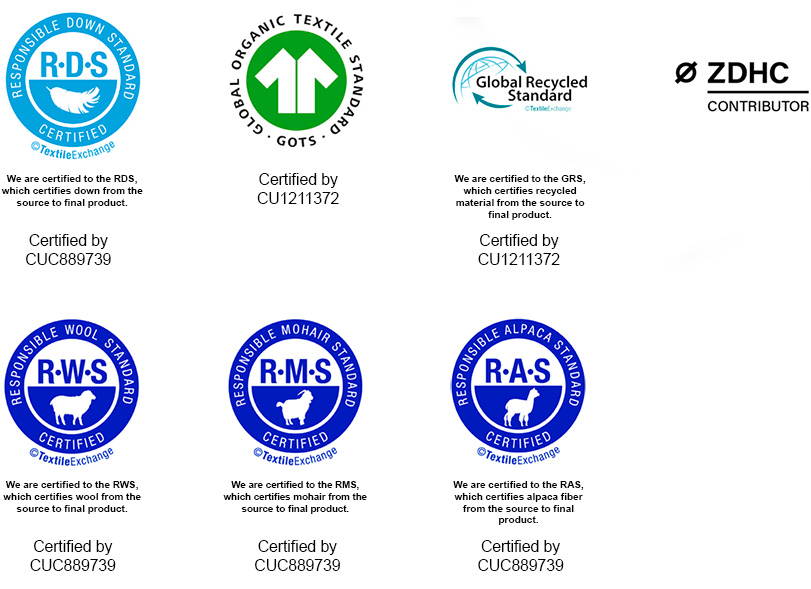Certificazioni

TINTORIA EMILIANA
Tinto in capo e pratiche sostenibili
Il presente e il futuro per Tintoria Emiliana sono la responsabilità che un’impresa sostenibile in senso ecologico deve assumere facendo scelte in grado di abbassare l’impatto ambientale delle proprie attività produttive contenendo i consumi. Oggi Tintoria Emiliana utilizza un impianto fotovoltaico da 450 kilowatt per la riduzione dei consumi energetici.
Le sue certificazioni:
ZDHC contributor, Tintoria Emiliana ha aderito su base volontaria al programma Roadmap to Zero che impone di evitare l’utilizzo di alcune sostanze altamente inquinanti, di gestire e migliorare i processi e la gestione dei prodotti chimici. GOTS (Global Organic Textile Standard) prevede il mantenimento della tracciabilità lungo l’intero processo produttivo, le restrizioni nell’uso dei prodotti chimici ed il rispetto di criteri ambientali e sociali in tutte le fasi della filiera produttiva.
GRS (Global Ricicle Standard) lo standard che riconosce l’importanza del riciclo per la crescita di un modello di produzione e consumo sostenibile.
RDS (Responsable Down Standard) che certifica prodotti che contengono piume e piumino provenienti da allevamenti certificati.
L’azienda sta collaborando con SBP per la quantificazione della carbon foot print e dell’ICA (Life Cycle Assessment) un metodo strutturato e standardizzato a livello internazionale che permette di quantificare i potenziali impatti sull’ambiente e sulla salute umana associati a un bene o servizio, a partire dal rispettivo consumo di risorse e dalle emissioni.
Inoltre è in corso di studio e sviluppo per il 2023 l’utilizzo di un nuovo depuratore capace di recuperare le materie prime secondarie dalle acque reflue con un contenimento delle risorse idriche necessarie ai processi di lavorazione del prodotto.
RDS (Responsable Down Standard) che certifica prodotti che contengono piume e piumino provenienti da allevamenti certificati.
RAF (Responsabile fibra animale) che comprende:
Responsabile standard lana (Versione 2.2), Responsabile standard Mohair (Versione 1.2), Responsabile standard Alpaca (Versione 1.0)
RAF (Animal Fibre Manager) which includes:
Wool Standard Manager (Version 2.2), Mohair Standard Manager (Version 1.2), Alpaca Standard Manager (Version 1.0)
TINTORIA EMILIANA
Garment dyeing and sustainable practices
The present and the future for Tintoria Emiliana is the responsibility that a sustainable company in the ecological sense must assume by making choices that can lower the environmental impact of its production activities while containing consumption. Today Tintoria Emiliana uses a 450-kilowatt photovoltaic system to reduce energy consumption.
Its certifications:
ZDHC contributor, Tintoria Emiliana has voluntarily adhered to the Roadmap to Zero program, which requires it to avoid the use of certain highly polluting substances and to manage and improve its processes and management of chemical products.
GOTS (Global Organic Textile Standard) requires the maintenance of traceability throughout the production process, restrictions on the use of chemicals, and compliance with environmental and social criteria at all stages of the production chain. GRS (Global Ricicle Standard) the standard that recognizes the importance of recycling for the growth of a sustainable production and consumption model.
RDS (Responsable Down Standard) which certifies products that contain feathers and down from certified farms.
The company is collaborating with SBP to quantify the carbon foot print and ICA (Life Cycle Assessment) a structured and internationally standardized method for quantifying the potential environmental and human health impacts associated with a good or service from its respective resource consumption and emissions.
Also under study and development for 2023 is the use of a new water treatment plant capable of recovering secondary raw materials from wastewater with a containment of water resources required for product processing.

